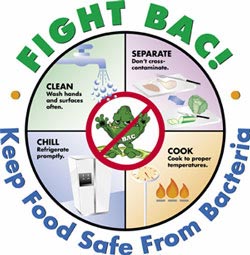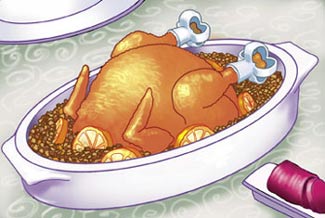 KINGSTON, R.I. — November 10, 2004 — As friends and family gather for holiday season meals, a University of Rhode Island food safety expert warns that buffet-style gatherings, when foods are often left out for extended periods of time, can invite unwanted guests to the table — harmful bacteria that cause food-borne illnesses.
KINGSTON, R.I. — November 10, 2004 — As friends and family gather for holiday season meals, a University of Rhode Island food safety expert warns that buffet-style gatherings, when foods are often left out for extended periods of time, can invite unwanted guests to the table — harmful bacteria that cause food-borne illnesses.
“You won’t even know they were there until a few days later,” said Martha Smith Patnoad, a Cooperative Extension food safety education specialist in URI’s Department of Nutrition and Food Sciences. “You can’t see them or taste them, but you’ll certainly know they were there if one of your guests gets a food-borne illness.”
Patnoad offers the following tips to ensure a food safe holiday season:
 1. Clean — Cleanliness is a major factor in preventing food-borne illnesses. Anything and everything that touches food should be clean. Always wash hands before and after handling food with warm soapy water, and regularly clean all kitchen surfaces that come in contact with food. Food should be served on clean plates, not those that were previously used for raw meat or poultry.
1. Clean — Cleanliness is a major factor in preventing food-borne illnesses. Anything and everything that touches food should be clean. Always wash hands before and after handling food with warm soapy water, and regularly clean all kitchen surfaces that come in contact with food. Food should be served on clean plates, not those that were previously used for raw meat or poultry.
2. Separate — Prevent cross-contamination, which occurs when harmful bacteria are transferred from one food to others. For instance, never cut raw meat, poultry, or fish on a cutting board and then slice salad vegetables on the same cutting board without washing the cutting board between uses. Similarly, on the buffet table, never add fresh food to a previously used dish that has been sitting on the buffet table for an extended period at room temperature. Instead, replace empty or almost empty dishes of food with clean full dishes of food.
3. Cook — Using a food thermometer is the only way to know if food has reached a high enough temperature to kill harmful bacteria. Food thermometers measure the internal temperature of foods, such as meat, hamburgers, poultry, egg casseroles, and any combination dishes to ensure that a safe temperature is reached and harmful bacteria like Salmonella and E. coli are destroyed.
 4. Keep warm — Foods should not sit at room temperature for more than two hours. Use chafing dishes, crock pots or warming trays to keep hot foods at 140 F or above. Keep track of how long foods have been sitting on the buffet table, and discard any foods that have been there for over two hours. Reheat hot foods to at least 165 F. Nest dishes of cold food in bowls of ice to keep them at 40 F or below. Keep food hot in the oven or cool in the refrigerator until serving time.
4. Keep warm — Foods should not sit at room temperature for more than two hours. Use chafing dishes, crock pots or warming trays to keep hot foods at 140 F or above. Keep track of how long foods have been sitting on the buffet table, and discard any foods that have been there for over two hours. Reheat hot foods to at least 165 F. Nest dishes of cold food in bowls of ice to keep them at 40 F or below. Keep food hot in the oven or cool in the refrigerator until serving time.
5. Chill — Make sure the temperature in the refrigerator is 40 F or below and 0 F or below in the freezer. Use a refrigerator/freezer thermometer to check the temperature. Harmful bacteria grow most rapidly in the danger zone between 40 F and 140 F. Food should spend as little time as possible in this temperature range. Refrigerate or freeze prepared food and leftovers within two hours of purchase or preparation. Thaw food in the refrigerator. For quick thawing, submerge in cold water in airtight packaging, or thaw in the microwave, and cook the food immediately.
For more information on keeping food safe and avoiding food-borne illnesses, call the URI gardening and food safety hotline at 1-800-448-1011 Monday through Thursday, 9 a.m. to 2 p.m.

